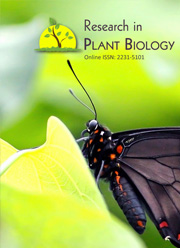Application of Chemometrics and HPLC Fingerprint for Species Differentiation and Authentication of the Genus Pterocarpus
DOI:
https://doi.org/10.25081/ripb.2023.v13.8292Keywords:
Hierarchical, Cluster, Analysis, Peaks, Gallic acid, TaxonomyAbstract
Pterocarpus species are well known for their nutritional and medicinal values, in order to examine the similarities or differences in the chemical profile of some common Pterocarpus species, four species of the genus namely; Pterocarpus erinaceus, P. mildbraedii, P. osun and P. santalinoides were analyzed using HPLC combined with Principal component analysis (PCA) and Hierarchical clustering analysis (HCA). This study aims to investigate the chemical fingerprints of the species and compare them in order to highlight the similarities in their chemical constituents. The ethanol extract of each sample was taken and filtered through a 0.45 μm millipore membrane filter and then transferred into the HPLC vial before injecting it into the HPLC machine. PCA and HCA were performed on the relative retention times and percentage peak composition. The species were chemically similar with nine (9) peaks in common, the most prominent peaks in all samples appeared at 3.26 min which corresponds to gallic acid (a known compound). Cluster analysis revealed some similar chemical variables with Gallic acid being the major compound in the Pterocarpus species and could be used as a marker compound for taxonomic purposes.
Downloads
References
Adamu, A., Esievo, K. B., Ugbabe, G., Okhale, S. E., & Egharevba, H. O. (2018). High performance liquid chromatography-diode array detection (HPLC-DAD) profiling, antioxidant and anti-proliferative activities of ethanol leaf extract of Berlinia grandiflora (Vahl) Hutch. & Dalziel. Journal of Pharmacognosy and Phytotherapy, 10(11), 187-194. https://doi.org/10.5897/JPP2018.0524
Adewuyi, A., Fasusi, O. H., & Oderinde, R. A. (2014). Antibacterial activities of acetonides prepared from the seed oils of Calophyllum inophyllum and Pterocarpus osun. Journal of Acute Medicine, 4(2), 75-80. https://doi.org/10.1016/j.jacme.2014.02.001
Aja, P. M., Offor, C. E., & Orji, O. U. (2015). Proximate and Antinutrient Compositions of Parkia biglobosa Fruits in Abakaliki, Ebonyi state, Nigeria. International Journal of Current Microbiology and Applied Sciences, 4(2), 394-398.
Aladesanmi, A. J. (2007). Tetrapleura tetraptera: molluscicidal activity and chemical constituents. African Journal of Traditional, Complementary, and Alternative Medicines, 4(1), 23-36.
Bosu, D. (2014). Rosewood, the most expensive and fastest selling commodity in Ghana today. Retrieved from https://www.linkedin.com/pulse/20140612161048-43734495-rosewood-the-most-expensive-and-fastest-selling-commodity-in-ghana-today
Deepa, R., Manjunatha, H., Krishna, V., & Swamy, K. (2015). Electrochemical Investigations of dopamine by gallic acid isolated from Pterocarpus marsupium Roxb carbon paste electrode: A voltammetric study. Research in Biotechnology, 6(2), 01-14.
Durugbo, E. U. (2013). Medico-Ethnobotanical inventory of Ogii, Okigwe Imo State, South Eastern Nigeria. Global Advanced Research Journal of Medicinal Plants, 2(2), 30-44.
Emebu, P. K., & Anyika, J. U. (2011). Proximate and Mineral Composition of Kale (Brassica oleracea) Grown in Delta State, Nigeria. Pakistan Journal of Nutrition, 10(2), 190-194. https://doi.org/10.3923/pjn.2011.190.194
Ezeokonkwo, M. A., & Okoro, U. C. (2012). New Dyes for Petroleum Products. Journal of Emerging Trends in Engineering and Applied Sciences, 3(1), 8-11.
Gabriel, A. F., & Onigbanjo, H. O. (2010). Phytochemical and Antimicrobial Screening of the Stem Bark Extracts of Pterocarpus erinaceus (Poir). Nigerian Journal of Basic and Applied Sciences, 18(1), 1-5.
Ibrahim, J. A., Egharevba, H. O., Iliya, I., Tarfa, F., & Ayodele, A. E. (2014). Chemical profiles as taxonominc tools for Loranthaceae in Nigeria. African Journal of Plant Science, 8(7) 343-352. https://doi.org/10.5897/AJPS2014.1161
Iroanya, O., Okpuzor, J., & Mbagwu, H. (2010). Anti-nociceptive and anti-phlogistic actions of a polyherbal decoction. International Journal of Pharmacology, 6, 31-36. https://doi.org/10.3923/ijp.2010.31.36
Li, Y., Kong, D., & Wu, H. (2018). Comprehensive chemical analysis of the flower buds of five Lonicera species by ATR-FTIR, HPLC-DAD, and chemometric methods. Revista Brasileira de Farmacognosia, 28(5), 533-541. https://doi.org/10.1016/j.bjp.2018.06.007
Manish, D., Arun, N., & Ansari, S. H. (2009). Pterocarpus marsupium Roxb. - A Comprehensive Review. Pharmacognosy Reviews, 3(6), 359-363.
Ndukwe, O. K., & Ikpeama, A. (2013). Comparative Evalutation of the Phytochemical and Proximate Constituents of OHA (Pterocarpus Soyansii) and Nturukpa (Pterocarpus Santalinoides) Leaves. International Journal of Academic Research in Progressive Education and Development, 2(3), 2226-6348.
Nwokorie, C. C., Nwachukwu, N. Dunga, K., & Ike, C. (2015). The Phytochemical Screening and Nutritional Compositions of Pterocarpus Santalinoides Plant. Researchjournali’s Journal of Public Health, 1(4), 1-11.
Ogukwe, C. E., Oguzie, E. E., Unaegbu, C., & Okolue, B. N. (2004). Phytochemical Screening on the leaves of Sansevieria trifasciata. Journal of Chemical Society of Nigeria, 29(1), 8-9.
Osuagwu, G. G. E. (2008). Proximate and Vitamin content of for Nigerian Pterocarpus Species. Nigerian Food Journal, 26(1), 21-26. https://doi.org/10.4314/nifoj.v26i1.47419
Raj, P. D., Dutt, P. N., Bahadur, S. D., Narayan, Y. U., & Prasad, K. D. (2017). Phytochemical screening and study of antioxidant, antimicrobial, antidiabetic, anti-inflammatory and analgesic activities of extracts from stem wood of Pterocarpus marsupium Roxburgh. Journal of Intercultural Ethnopharmacology, 6(2), 170-176.
Su, Z., Wang, P., Yuan, W., & Li, S. (2014). Chemical Constituents from Pterocarpus soyauxii. Natural Product Communications, 9(10), 1483-1486.
The Plant List. (2013). Missouri Botanical Garden. Kew, UK: Royal Botanic Gardens.
Uchegbu, R. I., & Okwu, D. E. (2012). An Evaluation of the Phytochemical and Nutrient Composition of the seed and stem Bark of Deterium Senegalense Gmelim. Journal of Natural Sciences Research, 2(5), 107-111.
Uchegbu, R. I., Gabriel, U. I., Uche, E. E., Chioma, O. I., & Kenneth, O. A. (2013). Identification of Phytochemicals Present in the Leaves of Pterocarpus Mildbraedii Harms by GC/MS Analysis. IOSR Journal of Applied Chemistry, 8(7), 06-10.
Udaysing, H. P., & Gaikwad, D. K. (2011). Phytochemical Screening and Microbicidal Activity of Stem Bark of Pterocarpus marsupium. International Journal of Pharma Sciences and Research, 2(1), 36-40.
Ujowundu, C. O., Okafor, O. E., Agha, N. C., Nwaogu, L. A., Igweland, K. O., & Igwe, C. U. (2013). Phytochemical and chemical composition of Combretum zenkeri leaves. Journal of Medicinal Plants Research, 4(10), 965-968. https://doi.org/10.5897/JMPR10.170
Usunobun, U., & Chinwe, I. V. (2016). Phytochemical screening, mineral composition and in vitro antioxidant activities of Pterocarpus mildbraedii leaves. International Journal of Scientific World, 4(1), 23. https://doi.org/10.14419/ijsw.v4i1.6066
Published
How to Cite
Issue
Section
Copyright (c) 2023 Taoheed Kolawole Muftaudeen, Adamu Aliyu, Jemilat A. Ibrahim

This work is licensed under a Creative Commons Attribution-NonCommercial-NoDerivatives 4.0 International License.



 .
. 